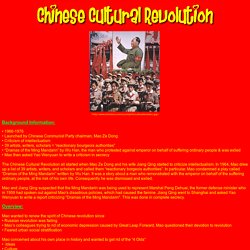

Chinese Cultural Revolution. Background Information: • 1966-1976 • Launched by Chinese Communist Party chairman, Mao Ze Dong • Criticism of intellectualism • 39 artists, writers, scholars = “reactionary bourgeois authorities” • “Dramas of the Ming Mandarin” by Wu Han, the man who protested against emperor on behalf of suffering ordinary people & was exiled • Mao then asked Yao Wenyuan to write a criticism in secrecy The Chinese Cultural Revolution all started when Mao Ze Dong and his wife Jiang Qing started to criticize intellectualism.

In 1964, Mao drew up a list of 39 artists, writers, and scholars and called them “reactionary borgeois authorities”. In particular, Mao condemned a play called “Dramas of the Ming Mandarin” written by Wu Han. It was a story about a man who remonstrated with the emperor on behalf of the suffering ordinary people, at the risk of his own life. Overview: Treaty ports in China. China -- the cake of kings and... of emperors" (a French pun on king cake and kings and emperors wishing to "consume" China).

French political cartoon from 1898. A pastry represents "Chine" (French for China) and is being divided between caricatures of Queen Victoria of the United Kingdom, William II of Germany (who is squabbling with Queen Victoria over a borderland piece, whilst thrusting a knife into the pie to signify aggressive German intentions), Nicholas II of Russia, who is eyeing a particular piece, the French Marianne (who is diplomatically shown as not participating in the carving, and is depicted as close to Nicholas II, as a reminder of the Franco-Russian Alliance), and a samurai representing Japan, carefully contemplating which pieces to take. A stereotypical Qing official throws up his hands to try and stop them, but is powerless. China 1911 90 Waugh. Communists, Nationalists, and China's Revolutions: Crash Course World History #37. CHINA- JOHNdCLARE.
Chinese Revolution. The webserver at Alpha History tells us you’re using an adblocking tool, plug-in or browser extension on your computer or network.

We understand that many people don’t like web-based advertising. Ads on websites can often be irrelevant, distracting and ‘in your face’. Without ads, however, our website would not exist – or it would not be free. Ads are how we fund the creation and delivery of our content. We love providing free textbook-quality content and resources to people like you. If you would like to use our website and its resources, please disable your adblocker or whitelist our website.
To access the Alpha History website, please complete one of the following steps: * Disable or deactivate your adblocking software, tool or plug-in. * Whitelist our top level domain (alphahistory.com) in your adblocking software. Thank you for your understanding. Have a nice day! Alpha History staff. Maos-china-1930-76 - Ben walsh. The Chinese Revolution of 1949 - 1945–1952. On October 1, 1949, Chinese Communist leader Mao Zedong declared the creation of the People’s Republic of China (PRC).

The announcement ended the costly full-scale civil war between the Chinese Communist Party (CCP) and the Nationalist Party, or Kuomintang (KMT), which broke out immediately following World War II and had been preceded by on and off conflict between the two sides since the 1920’s.
Oops! - ABC Radio. Mao's Great Famine HDTV great leap foward, history of china. Chairman Mao Documentary - The Cultural Revolution - Destruction Of China. Part 13: The Republic of China [ 1912-1949 ] If the second half of the 19th century was bad, the first half of 20th would be worse.
![Part 13: The Republic of China [ 1912-1949 ]](http://cdn.pearltrees.com/s/pic/th/chinese-history-republic-120610066)
Millions more would die after an unrelenting succession of wars, floods, drought and famine. After the fall of empire, China’s political landscape changed dramatically and would soon be dominated by the Kuomintang (KMT or Nationalist Party) and the Chinese Communist Party (CCP). Emboldened by successful wars against China and Russia, Japanese aggression continues to build. At the same time, Europe’s aggressive empire-building starts to fade, as they become increasingly preoccupied by bigger problems back home. Japanese troops shelling Qingdao 1914: World War I breaks out. 1919: After WWI ends, the Paris Peace Conference meets to set the peace terms for Germany and other defeated nations. THE HENAN (HONAN) FAMINE OF 1943-44 IN CHINA. In 1943 and 1944 the provice of Henan in China experienced a terrible famine.

It came as a result of drought and warfare but the Nationalist Government not only failed to remedy the food shortage it through its unrelenting taxation made it far worse than would have been. As a famine it might not have been worse than other famines which occurred in China in the past but it is the only one for which we have a detailed description. The American journalist Theodore H. White gave us an eye witness account. 12 h henan Famine 1943 4. Mao's Bloody Revolution. Political, Social, Cultural, Historical Analysis Of China. Re-organization of the CCP Central Organization Department Transplant Of The Purge of Trotskyists Gao Hua stated that Mao Tse-tung came to like Wang Ming's talk of "purging Trotskyites" when Wang Ming objected to Chen Duxiu's return to the CCP as well as accused Zhang Wentian of being influenced by Trotsky while in Moscow.

From 1938 onward, per GH, Mao never forgot to curse the "Japanese imperialists, Trotskyites and traitors" in his lumpsome speeches. Chinese communist revolution 1949.